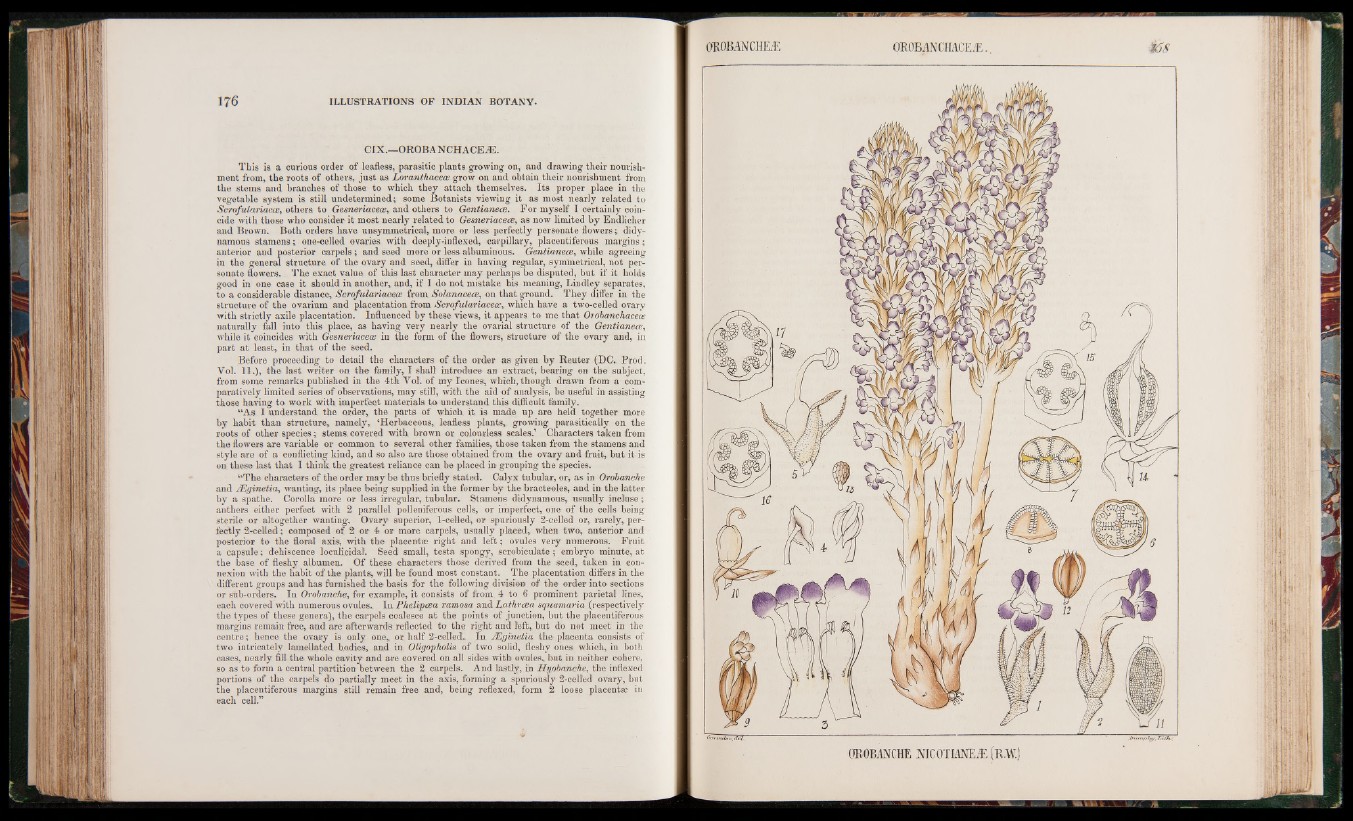
CIX.—ORQBA NCHACEA5.
This is a curious order of leafless, parasitic plants growing on, and drawing their nourishment
from, the roots of others, just as Loranthacece grow on and obtain their nourishment from
the stems and branches of those to which they attach themselves. Its proper place in the
vegetable system is still undetermined; some Botanists viewing it as most nearly related to
Scrofulariacce, others to Gesneriacece, and others to Gentianece. For myself I certainly coincide
with those who consider it most nearly related to Gemeriacece, as now limited by Endlicher
and Brown. Both orders have unsymmetrical, more or less perfectly personate flowers; didy-
namous stamens; one-celled ovaries with deeply-inflexed, carpillary, placentiferous margins;
anterior and posterior carpels ; and seed more or less albuminous. Gentianece, while agreeing
in the general structure of the ovary and seed, differ in having regular, symmetrical, not personate
flowers. The exact value of this last character may perhaps be disputed, but if it holds
good in one case it should in another, and, if I do not mistake his meaning, Lindley separates,
to a considerable distance, Scrqfulariacece from Solanacece, on that ground. They differ in the
structure of the ovarium and placentation from Scrofulariacece, which have a two-celled ovary
with strictly axile placentation. Influenced by these views, it appears to me that Orobanchacece
naturally fall into this place, as having very nearly the ovarial structure of the Gentianece,
while it coincides with Gesneriaceoe in the form of the flowers, structure of the ovary and, in
part a t least, in that of the seed.
Before proceeding to detail the characters of the order as given by Reuter (DC., Prod.
Vol. 11.), the last writer on the family, I shall introduce an extract, bearing on the subject,
from some remarks published in the 4th Vol. of my leones, which,, though drawn from a comparatively
limited series of observations, may still, with the aid of analysis, be useful in assisting
those having to work with imperfect materials to understand this difficult family.
“As I understand the order, the parts of which it is made up are held together more
by habit, than structure, namely, ‘Herbaceous,, leafless plants,, growing parasitically on the
roots of other species; stems, covered with brown or colourless scales.’ Characters taken from
the flowers are variable or common to several other families, those taken from the stamens and
style are of a conflicting kind, and so also are those obtained from the ovary and fruit, but it is
on these last that, I think the greatest reliance can be placed in grouping the species.
“The characters of the order may be thus briefly stated. Calyx tubular, or, as in Ovobanche
and JEgvnetia, wanting, its place being supplied in the former by the bracteoles, and in the latter
by a spathe. Corolla more or less irregular, tubular. Stamens didynamous, usually incluse;
anthers either perfect with 2 parallel polleniferous cells, or imperfect, one of the cells being
sterile or altogether wanting. Ovary superior, 1-celled, or spuriously 2-celled or, rarely, perfectly
2-celled; composed of 2 or -4 or more carpels, usually placed, when two, anterior and
posterior to the floral axis, with the placentae right and le ft; ovules very numerous. Fruit
a capsule; dehiscence loculicidal. Seed small, testa spongy, scrobiculate; embryo minute, at
the base of fleshy albumen. Of these characters those derived from the seed, taken in connexion
with the habit of the plants, will be found most constant. The placentation differs: in the
different groups and has furnished the basis for the following division of the order into sections
or sub-orders. In Ovobanche, for example, rt consists of from. 4 to 6 prominent parietal lines,
each covered with numerous ovules. In Phelvpcea ramosa and Lathrcea squamaria (respectively
the types of these genera), the carpels coalesce at the points of junction, but the placentiferous
margins remain free, and are afterwards, reflected to the right and left, but do not meet in the
centre; hence the ovary is only one,, or half 2-celTed., In JKginetia the placenta consists of
two intricately lamellated bodies, and in Oligopholis of two solid, fleshy ones which, in both
cases, nearly fill the whole cavity and are eovered on all sides with ovules, but in neither cohere,
so as to form a central partition between the 2 carpels. And lastly, in Hyobancke, the inflexed
portions of the carpels do partially meet in the axis, forming a spuriously 2-cell'ed ovary, but
the placentiferous margins still remain free and, being reflexed, form 2 loose placentae in
each cell.”
0K0BANCHEÆ OROBANCHACEÆ.. S s
(BOBANCHE MCOTIANEÆ (R.W.